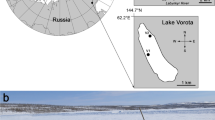Abstract
Vertical distribution of the main bacteria isolated from the Muztagata ice core (about 22.4 m) was investigated by means of cultivation and 16S rRNA sequence analysis. The results showed that the amount of culturable bacteria fluctuated with ice core depth, and was more in dirty layer than in clean ice, which suggested the close corresponding relationship between high input of the bacteria deposited by wind and snowflow and dirty layer. Most of the bacteria were psychrophiles and psychrotolerants, including α- and γ-proteobacteria, Cryobacterium psychrophilum, CFB (Cytophaga-Flavobacterium-Bacteroides) group, high-G+C gram-positive bacteria (HGC). Acinetobacter sp. and HGC repeatly occurred in different ice depths, and their quantitative distribution was consistent with the change of the total amount of culturable bacteria with depth, which suggested the main bio-indicator; while Flavobacterium, Cryobacterium psychrophilum, and α-proteobacteria, also functioned as a secondary indicator of climatic and environmental changes. This study is the first report concerning continuous quantitative variation and pattern of the main culturable bacteria in ice core section.
Similar content being viewed by others
References
Burkins, M. B., Virginia, R. A., Chamberlain, C. P. et al., Origin and distribution of soil organic matter in Taylor Valley, Antarc., Ecol., 2000, 81: 2377–2391.
Ma, L. J., Catharine, M. C., Starmer, W. T. et al., Revival and characterization of fungi from ancient polar ice, Mycologist, 1999, 13: 70–73.
Cameron, R. E., Morelli, F. A., Johnson, R. M., Bacterial species in soil and air of the Antarctic Continent, Antarc. J. U.S., 1972, 7: 187–189.
Rogers, S. O., Ma, L., Castello, J. D. et al., Dilemmas and enigmas encased in ancient ice, XVI Internatioal Botanical Congr. Abs., 1999, 452.
Castello, J. D., Rogers, S. O., Starmer, W. T. et al., Detection of tomato mosaic tobamovirus RNA in ancient glacial ice, Polar Biol., 1999, 22: 207–212. [DOI]
Banttari, E. E., Venette, J. R., Aerosol spread of plant viruses: Potential role in disease outbreaks, Ann. New York Acad. Sci., 1980, 353: 167–173.
Abyzov, S. S., Microorganisms in the Antarctic ice (ed. Friedman, E. I.), Antarctic Microbiology, New York: Wiley-Liss, 1993, 265–295.
Abyzov, S. S., Mitskevich, I. N, Poglazova, M. N., Microflora of the deep glacier horizons of central Antarctica, Microbiol. (Moscow), 1998, 67: 66–73.
Yoshimura, Y., Kohshima, S., Takeuchi, N., Himalayan ice-core dating with snow algae, J. Glaciol., 2000, 46(153): 335–340.
Yao, T. D., Xiang, S. R., Zhang, X. J. et al., Microbiological characeteristics recorded by Manlan and Puruogangri ice core, Quatern. Sci., 2003, 23: 193–199.
Priscu, J. C., Adams, E. E., Lyons, W. B. et al., Geomicrobiology of subglacial ice above Lake Vostok, Antarc. Sci., 1999, 286: 2141–2144.
Siebert, J., Hirsch, P., Characterization of 15 selected coccal bacteria isolated from Antarctic rock and soil samples from the McMurdo-Dry Valleys (southern Victoria Land), Polar Biol., 1988, 9: 37–44. [DOI]
Claus, W. G., Understanding Microbes (ed. Freeman, W.H.), New York: W H Freeman Company, 1989, 51–72.
Altschul, S. F., Gish, W., Miller, W. et al., Basic local alignment search tool, J. Mol. Biol., 1990, 215: 403–410. [DOI]
Kumar, S., Tamura, K., Nei, M., MEGA molecular evolutionary genetics analysis Version 1.01, Pennsylvania State University, 1993.
Miskin, I., Glenn, R., Kirsten, L. et al., Bacteria in post-glacial freshwater sediments, Microbiol., 1998, 144: 2427–2439.
Gilichinsky, D. A., Khlebnikova, G M., Zvyagintsev, D. G et al., The use of microbiological characteristics of rocks in geocryology, Proc. 5th Int Conf. Permafrost, 1988, 1: 749–753.
Gilichinsky, D. A., Vorobyova, E. A., Erokhina, L. G. et al., Long-term preservation of microbial ecosystems in permafrost, Adv. Space Res., 1992, 12: 255–263. [DOI]
Balkwill, D. L., Numbers, diversity, and morphological characteristics of aerobic, chemoheterotrophic bacteria in deep subsurface sediments from a site in South Carolina, Geomicrobiol. J., 1989, 7: 33–52.
Shi, T., Reeves, R. H, Gilichinsky, D. A. et al., Characterization of Viable Bacteria from Siberian Permafrost by 16S rDNA Sequencing, Microbial Ecol., 1997, 33: 169–179. [DOI]
Bowman, J. P., McCammon, S. A., Brown, M. V. et al., Diversity and association of psychrophilic bacteria in Antarctic sea ice, Appl. Environ. Microbiol., 1997, 63: 3068–3078.
Helmke, E., Weyland, H., Bacteria in sea ice and underlying water of the eastern Weddell Sea in midwinter, Mar. Ecol. Prog. Ser., 1995, 117: 269–287.
Christner, B. C., Thompson, E. M., Thompson, L. G. et al., Recovery and identification of viable bateria immured in glacier ice, Icarus, 2000, 144: 479–485. [DOI]
DeLong, E. F., Franks, D. G., Yayanos, A. A., Evolutionary relationships of cultivated psychrophilic and barophilic deep-sea bacteria, Appl. Environ. Microbiol., 1997, 63: 2105–2108.
Maruyama, A., Honda, D., Yamamoto, H. et al., Phylogenetic analysis of psychrophilic bacteria isolated from the Japan Trench, including a description of the deep-sea species Psychrobacter pacicensis sp. nov., Int. J. Syst. Evol. Microbiol., 2000, 50: 835–846.
Christner, B. C., Thompson, E. M., Thompson, L. G. et al., Bacterial recovery from ancient glacial ice, Environ. Microbiol., 2003, 5(5): 433–436. [DOI]
Zhang, X. J., Ma, X. J., Yao, T. D. et al., Diversity of 16S rDNA and environmental factor influencing microorganisms in Malan ice core, Chinese Sci. Bull., 2003, 48(11): 1146–1151.
Gounot, A. M., Efects of temperature on the growth of psychrophilic bacteria from glaciers, Can. J. Microbiol., 1976, 22(6): 839–46.
Xiang, S. R., Yao, T. D., An, L. Z. et al., Bacterial diversity in Malan Ice Core from the Tibetan Plateau, Folia Microbiol., 2004, 49(3): 269–276.
Rutter, M., Nedwell, D. B., Influence of changing temperature on growth rate and competition between two psychrotolerant Antarctic bacteria: competition and survival in non-steady-state temperature environments, Appl. Environ. Microbiol., 1994, 60(6): 1993–2002.
Author information
Authors and Affiliations
Corresponding author
Rights and permissions
About this article
Cite this article
Xiang, S., Yao, T., An, L. et al. Vertical quantitative and dominant population distribution of the bacteria isolated from the Muztagata ice core. Sci. China Ser. D-Earth Sci. 48, 1728–1739 (2005). https://doi.org/10.1360/02yd0210
Received:
Revised:
Published:
Issue Date:
DOI: https://doi.org/10.1360/02yd0210




